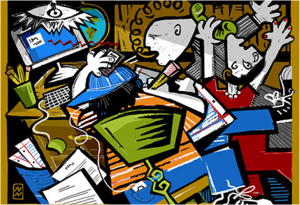Celebrating 27 Years as a Woman in Business
This month marks the 27th anniversary of the firm I founded in 1993, System Strategies Consulting. What initially started out as consulting on software development and system implementations ‘on the side’, became a decades-long endeavor that grew and prospered as did my two children.
While not many flexible career options existed in 1993 for new moms, I was determined to continue my professional career and be a strong presence and positive influence in the lives of my two children, then ages 1 and 3. Job sharing, flextime, freelancing and telecommuting were not yet mainstream. Yet I was not willing to give up on being an involved mom and a professional. Having worked myself through graduate school and taking increasingly more complex roles in my career in healthcare technology, I had become the Director of Information Systems in a health system before my children were born. After my first child, I continued in that role, taking a 3-month maternity leave which was partially paid through my vacation and sick time and unpaid for the remainder. That was 1990, before legislation to mandate (albeit unpaid) maternity leave with a job guaranteed upon return. I was fortunate to work for a health system who generously granted me time off and held my job in the meantime. This employer also provided on-site childcare which enabled me to visit and nurse my son throughout the workday. Two years later though, with two children under 3, I decided to spend a year of dedicated time with my family and worked only part-time evenings, teaching at a local college. At the end of that year, I wanted to get more fully back to work, using my experience and education which I had worked hard to attain.
My former health system employer hired me for several projects on a contract basis – a lab system selection and implementation, report design, and a revenue system migration. I began contacting my colleagues and other health systems in the region, which resulted in a few more opportunities, though several tried vehemently to hire me as an employee, not fully supporting the idea of an independent female contractor. By then I realized the feasibility and challenges of working for myself, and I fought to preserve this opportunity. Self-employment surely had its benefits – it was becoming more professionally interesting and more lucrative due to a wide variety of engagements and clients. I was able to manage my schedule such that I could choose my working hours and thereby minimize childcare demands. I could for the most part determine when I would be on-site at a client’s location and when to work from my home office, all decades before telecommuting became acceptable. I proved to myself (and my clients) that I could produce the work and raise my family, on terms that were agreeable to all involved. There was no going back. I had inadvertently become an entrepreneur and was in business for myself.
There were hurdles that left me questioning my resolve, however. Early on, an IT manager at a large health system offered me a 2-month exclusive engagement at a sub-standard hourly rate. Though this was a possible foot-in-the-door opportunity which could have led to much future work, it was tenuous at best. Its limited duration meant I would have needed to make temporary childcare arrangements, disrupting my children’s lives for a short period of time; its exclusivity requirement meant I would not be free to work simultaneously for other clients; its low compensation meant I would be accepting a rate I knew was not competitive for someone with my skills. I simply couldn’t accept the terms of this engagement. I had already sacrificed job security by going out on my own; maintaining autonomy and openness to additional work was critical. I had also previously decided I wanted a stable childcare arrangement for my children, with me as the central figure. I, as did many working mothers, wanted to balance a career and a family, and I had started putting things in place for that to happen. I was not willing to relinquish those dreams for a ‘try-out’ engagement of limited commitment and sub-standard terms. I knew what I had to offer. So, I went back to that manager and confidently expressed my interest in the work – but with a longer-term non-exclusive engagement, flexible hours, and at the competitive rate. Did it work? Were my presumably bold demands met? Actually, no. That manager did not accept my terms.
However, he did recommend me to a colleague (a woman director) who proceeded to offer me a 6-month, competitive-rate, flexible engagement for an exciting new software design and development project, which was the start of continuous engagements with this client for over 20 years. Over time on occasion, I came to work with the very manager who originally rejected my terms, in mutually respectful collaborations within his organization. My reputation as a competent professional and trusted partner had been established. That initial rejection experience, for me, provided lessons in confidence, respect, standing up for my values, and assertive negotiation, and from which I have often drawn insights throughout my 27 years in business. The failed negotiation nonetheless confirmed and validated my aspirations, allowed me to uphold my values and respectfully decline unacceptable terms without compromising my relationship with the individual and his organization. It cemented in me the idea that assertive behavior is a gift to the self and to others.
Over time, my work expanded to meet client demands, including management consulting, project management, strategic planning, system design, implementations large and small, process engineering, training, technical documentation, policy development and system migrations. I brought in sub-contractors as needed to supplement projects with specific resource or technical expertise requirements. Even my kids, as teenagers, helped in the office.
My journey led me through virtually all departments within a hospital, from radiation oncology to perinatal, from bed management to public safety, from OR to ER, from care plans to claims. It allowed me the privilege of shadowing and consulting with physicians, clinicians, C-suite executives, IT professionals, office clerks, other vendors and facilities staff. The inner workings of the healthcare system, including all its glories, innovations, and challenges, and its growing adoption of technology became ingrained in who I am as a professional and continues to inspire and fascinate me.
As the business grew, so did my children. By the time they were in school, I was frequently able to craft my workdays to enable me to catch their afternoon ballgames or musical performances. This meant carefully planning meeting schedules and setting client expectations to allow for an occasional early departure. It meant relying on my supportive husband (also a business-owner!) to take on more parenting duties on days when I had an important presentation or critical meeting. Though there were many late evenings spent catching up on work, the arrangement worked for my family and my clients. I was fortunate to have support from my extended family, and from phenomenal teachers and child caregivers. My children benefitted from seeing their mother work hard and enjoy fulfilling and meaningful work, and they learned powerful lessons in compromise, compassion, choices and overcoming challenges. I believe it showed them also that we can all craft our own unique journey and prosper in ways seemingly unimaginable when we first begin.
It wasn’t always easy. Immediately upon starting the business, I became accountant, COO, CEO, contract negotiator and office janitor all at once. As an entrepreneur, one must manage all aspects of the business in addition to the deliverables and work product. Taxes, infrastructure, business development, liability and other business responsibilities were new to me as a software professional. I became a lifelong learner, as one who owns a business must. There were slow periods and times of seemingly unmanageable overload. I learned to trust and rely on others. I’m grateful to those who serve as my advisors on parts of the business which challenge me. I have learned so much from my colleagues and clients and am thankful for their participation in my journey so far.
All businesses must adapt to survive. Through the last decade, changes in healthcare, legislation and technology called for different skills and services. Seven years ago, I pursued formal training as a coach, furthering my graduate studies in cognitive psychology. I introduced executive coaching as a new service line in the firm. With the kids finishing college, I was positioned to sustain this risk as I pivoted the business toward supporting leaders in technology and healthcare. In coaching, I see new and old challenges facing executives and professionals today. In tech, healthcare and other industries, women and men face mounting demands for leadership skills, fiscal responsibility, and business development. In growing my firm over the last 27 years, I learned how empathy, communication, values, and resilience are the foundation for a sustainable career and personal fulfillment. Because these areas have been so crucial to my own success, I created a leadership development program around these behaviors to inspire others. This program, ‘Skills That Build’, shares evidence-based science and learned behaviors which can improve our lives at work and at home. It is the subject of a book I am writing to reach those who would otherwise have little access to coaching.
I would have hoped that nearly 30 years after starting System Strategies Consulting, I could say it has become easier for women to own a business and rise to the highest levels in the technology industry. Unfortunately, I cannot yet make that statement unequivocally. Yes, there are better laws for family leave, more funding for minority and women-owned businesses, and an emphasis on STEM education for girls. Yet we can do more. We can and must empower individuals to work toward their full potential, learning behaviors and skills which promote healthy living and fulfilling work. We can teach and cultivate confidence, self-esteem, assertive communications, autonomy, competence, resilience and, perhaps most importantly, hope, in the young and those who aspire to great things. And, then, when someone tells these hopeful, aspiring individuals ‘No.’, they will have developed the courage and strength to stand up for their values and look for the next open door. Or, maybe even knock and open that door for themselves.


 rly articulate your goal and establish a path to overcome existing barriers and achieve it. Your coach will help you develop awareness of your strengths, resources and skills that can be mustered in developing your own unique strategy for success. An important part of the coaching process is learning to recognize any existing bias, destructive thought patterns, language and behaviors which are working against you. This is perhaps the most critical discovery among coaching clients. Removing barriers and learning new ways to think about situations, using constructive language and reinforcing behaviors are also crucial to a successful coaching experience. Coach and client work together to explore opportunities, create an action plan and carefully monitor progress against that plan, in a relationship built on trust, support and confidentiality.
rly articulate your goal and establish a path to overcome existing barriers and achieve it. Your coach will help you develop awareness of your strengths, resources and skills that can be mustered in developing your own unique strategy for success. An important part of the coaching process is learning to recognize any existing bias, destructive thought patterns, language and behaviors which are working against you. This is perhaps the most critical discovery among coaching clients. Removing barriers and learning new ways to think about situations, using constructive language and reinforcing behaviors are also crucial to a successful coaching experience. Coach and client work together to explore opportunities, create an action plan and carefully monitor progress against that plan, in a relationship built on trust, support and confidentiality.

